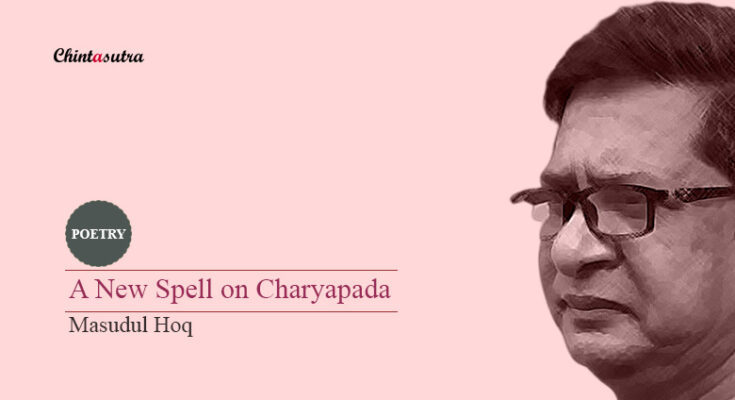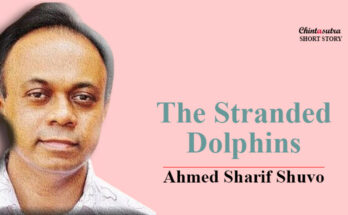A New Spell on Charyapada-1
Human body is an unknown tree inside flesh and blood
It spreads five sense organs of different missions
Beneath it there lies eternity itself.
Only the restless mind stays awake
Amongst eternal sorrows and happiness.
Luipa realises the fact in meditation
That Death attracts him more than Life!
A New Spell on Charyapada-3
The vintner girl surrounds herself
Squeezing the wine slowly.
There are sixty-four arts and crafts in the body
The fiances become intoxicated in it
Thinking of the moon on the tenth day as a sign of love-making
They display their valiance of manhood in sixty-six sectors.
Tempted, humans run after immortality
And become slaves to wine in small jugs, and vessels.
Birupa thinks so while sitting in meditation
Happiness stands for a woman
And she lies in infatuation!
A New Spell on Charyapada-5
Human beings are an illusory tree
It keeps flowing in the stream of Styx.
An irresistible trap lies between the shores of illusion
In between keeps awake the storm of waves
The solution of ferrying remains within the body.
If the illusory tree is driven away in the pursuit of enlightenment
The fabrics of light of knowledge
will help Bard to build a bridge across the river.
The righteous do not move either left or right
They keep walking in the middle for thousands of years.
A New Spell on Charyapada-6
Humans are held in with deer-like frivolity
In a desperately-desired body
As if the deer is a foe to her own flesh!
Eternity is a weird hunter
Which surrounds the body with the spell of destruction.
Alongside desire there is beauty in the body
To a flesh-eater, the flesh of a deer still equates to the charms of a woman
As it was in ancient times.
Vusuku knows if human senses find
the spirit
They are sure to reach the Eden.
But the material world is a bond of illusion
And the body goes after the reproduction.
Even in a thousand years of pursuit of knowledge
I could not find the nonchalant light!
A New Spell on Charyapada-7
Obstructed by the illusion of the moon and the sun,
The poet Kanu happens to be so weary;
I ponder why he remains so nonchalant in an infinite glory
In a world full of greed.
Illusion-oratory and soul are all three the same in the mundane world;
Why the body suddenly becomes detached by the eclipse of bodily enemies.
Those who came abandon the body behind
And there is none to leave us.
They still tend to go to the Paradise beyond space and time
I am sure it’s Kanui who can give one the real hints.
(Translated into English by Niranjan Roy)
Note on Charyapada: The Charyapada is a collection of mystical poems, songs of self-realization in the Vajrayana tradition of Buddhism from the tantric tradition in Assam, Bengal, Bihar and Odisha.
It was written between the 8th and 12th centuries in an Abahatta that was the ancestor of the Assamese, Bengali, Bhojpuri, Odia, Magahi, Maithili, and many other Eastern Indo-Aryan languages, and it is said to be the oldest collection of verses written in those languages.
A palm-leaf manuscript of the Charyāpada was rediscovered in the early 20th century by Haraprasad Shastri at the Nepal Royal Court Library. The Charyapada was also preserved in the Tibetan Buddhist canon.
As songs of self-realization, the Charyapada was intended to be sung. These songs of realisation were spontaneously composed verses that expressed a practitioner’s experience of the enlightened state.
The rediscovery of the Charyapada is credited to Haraprasad Shastri, a 19th-century Sanskrit scholar and historian of Bengali literature who, during his third visit to Nepal in 1907, chanced upon 50 verses at the Royal library of the Nepalese kings. Written on trimmed palm leaves of 12.8×0.9 inches in a language often referred to as sāndhyabhāṣa or twilight language, a semantic predecessor of modern Bengali, the collection came to be called Charyapada and also Charyagiti by some. At that time, Shastri was a librarian of the Asiatic Society in Calcutta, and was engaged in a self-assigned mission to trace and track ancient Bengali manuscripts. His first and second trips to Nepal in 1897 and 1898 met with some success, as he was able to collect a number of folkloric tales written in Pali and Sanskrit. However, after he rediscovered the treasure manuscripts in 1907, he published this collections in a single volume in 1916. According to some historians, there may very likely have been at least 51 original verses which were lost due to absence of proper preservation. Based on the original Tibetan translation, the book was originally called Charyagitikosh and had 100 verses. The scrolls discovered by Shastri contained selected verses.
The original palm-leaf manuscript of the Charyapada, or Charyācharyāviniścaya, spanning 47 padas (verses) along with a Sanskrit commentary, was edited by Shastri and published from Bangiya Sahitya Parishad as a part of his Hajar Bacharer Purano Bangala Bhasay Bauddhagan O Doha (Buddhist Songs and Couplets) in 1916 under the name of Charyacharyavinishchayah. This manuscript is presently preserved at the National Archives of Nepal.
Scholars of Bengali language and literature consider Charyapadas to be the earliest specimens of Bengali literature. The poems of the poets of this Charyapada are the original inspiration of Bengali poetry. The influence of that poet and poetry still exists in Bengali language. In this series, the poet Masudul Hoq has created a new genre by applying the ideas of Charyapada’s poems in the recent times. This process of creation has started a new trend in Bengali poetry. He expressed the thoughts of the Charya poets in his own basic poetic style.
Comments
0 comments




